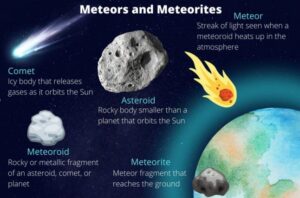You may think of outer space as a vast, empty void – but space is full of objects!
Both within and beyond the bounds of our solar system.
Have you ever wonders what heavenly bodies are? Well!they are names given for celestial bodies.
Lets unravel the mysteries behind these space objects in this blog!
A meteoroid is “a small, rocky or metallic body revolving in interplanetary space around the sun. In other words, a meteoroid is a “space rock” smaller than an asteroid.

A meteor is “a meteoroid that has entered Earth’s atmosphere.” Basically, it’s a small body of rock or metal that used to travel around in space, but that got sucked into Earth’s gravity. The friction from the atmosphere makes it heat up and glow, sometimes making it visible as it streaks through the sky. What’s visible from Earth is a bright, fiery streak in the sky. A particularly bright meteor can be called a bolide or a fireball, especially if it explodes.
A meteorite is “a mass of stone or metal that has reached Earth from space.” In other words, a meteorite is a meteoroid that enters Earth’s atmosphere but does not burn up entirely, instead surviving to crash into the surface. Meteorites tend to be bigger than the meteors that burn up before making it to the surface. A meteorite might look like a fireball as it crashes toward Earth, but it eventually cools.
An asteroid is “a millions of small celestial objects revolving around the sun, often irregularly shaped and having a great range in size.” Asteroids typically consist of rocks or metals. They’re bigger than meteoroids, but they can range from as small as six feet across to more than 600 miles across.
A comet is “a celestial body moving about the sun, usually in a highly eccentric orbit, consisting of a central mass surrounded by an envelope of dust and gas that may form a tail that streams away from the sun.” Comets consist mostly of ice, dust, and some rocky bits—they are sometimes nicknamed “dirty snowballs” for this reason. This sets them apart from asteroids, which are mostly rock or metal. Like asteroids, though, comets often orbit the sun. Comets are known for having a tail, which is really the trail that happens when this gaseous dust cloud is blown by solar wind or heat.
Coordinator: Daniel Miranda
